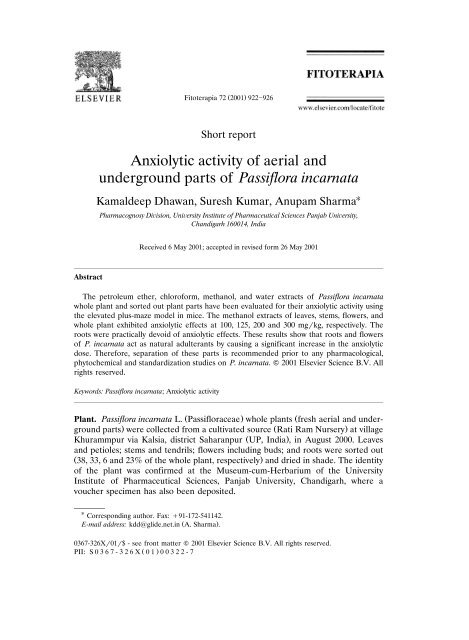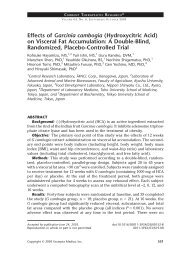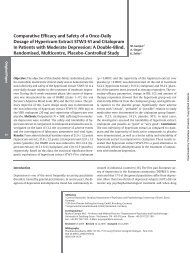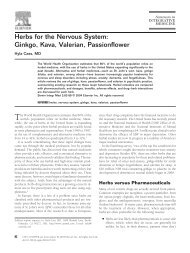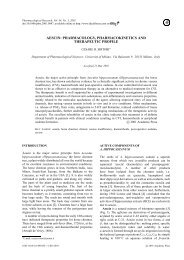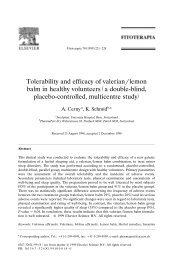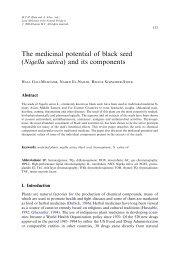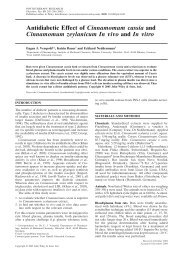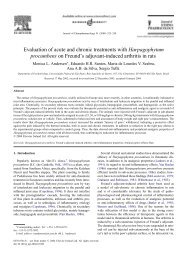Anxiolytic activity of aerial and underground parts of ... - Nutraxin
Anxiolytic activity of aerial and underground parts of ... - Nutraxin
Anxiolytic activity of aerial and underground parts of ... - Nutraxin
You also want an ePaper? Increase the reach of your titles
YUMPU automatically turns print PDFs into web optimized ePapers that Google loves.
Ž .<br />
Fitoterapia 72 2001 922926<br />
Short report<br />
<strong>Anxiolytic</strong> <strong>activity</strong> <strong>of</strong> <strong>aerial</strong> <strong>and</strong><br />
<strong>underground</strong> <strong>parts</strong> <strong>of</strong> Passiflora incarnata<br />
Kamaldeep Dhawan, Suresh Kumar, Anupam Sharma <br />
Pharmacognosy Diision, Uniersity Institute <strong>of</strong> Pharmaceutical Sciences Panjab Uniersity,<br />
Ch<strong>and</strong>igarh 160014, India<br />
Received 6 May 2001; accepted in revised form 26 May 2001<br />
Abstract<br />
The petroleum ether, chlor<strong>of</strong>orm, methanol, <strong>and</strong> water extracts <strong>of</strong> Passiflora incarnata<br />
whole plant <strong>and</strong> sorted out plant <strong>parts</strong> have been evaluated for their anxiolytic <strong>activity</strong> using<br />
the elevated plus-maze model in mice. The methanol extracts <strong>of</strong> leaves, stems, flowers, <strong>and</strong><br />
whole plant exhibited anxiolytic effects at 100, 125, 200 <strong>and</strong> 300 mgkg, respectively. The<br />
roots were practically devoid <strong>of</strong> anxiolytic effects. These results show that roots <strong>and</strong> flowers<br />
<strong>of</strong> P. incarnata act as natural adulterants by causing a significant increase in the anxiolytic<br />
dose. Therefore, separation <strong>of</strong> these <strong>parts</strong> is recommended prior to any pharmacological,<br />
phytochemical <strong>and</strong> st<strong>and</strong>ardization studies on P. incarnata. 2001 Elsevier Science B.V. All<br />
rights reserved.<br />
Keywords: Passiflora incarnata; <strong>Anxiolytic</strong> <strong>activity</strong><br />
Plant. Passiflora incarnata L. Ž Passifloraceae. whole plants Žfresh <strong>aerial</strong> <strong>and</strong> <strong>underground</strong><br />
<strong>parts</strong>. were collected from a cultivated source Ž Rati Ram Nursery.<br />
at village<br />
Khurammpur via Kalsia, district Saharanpur Ž UP, India ., in August 2000. Leaves<br />
<strong>and</strong> petioles; stems <strong>and</strong> tendrils; flowers including buds; <strong>and</strong> roots were sorted out<br />
Ž 38, 33, 6 <strong>and</strong> 23% <strong>of</strong> the whole plant, respectively.<br />
<strong>and</strong> dried in shade. The identity<br />
<strong>of</strong> the plant was confirmed at the Museum-cum-Herbarium <strong>of</strong> the University<br />
Institute <strong>of</strong> Pharmaceutical Sciences, Panjab University, Ch<strong>and</strong>igarh, where a<br />
voucher specimen has also been deposited.<br />
<br />
Corresponding author. Fax: 91-172-541142.<br />
Ž .<br />
E-mail address: kdd@glide.net.in A. Sharma .<br />
0367-326X01$ - see front matter 2001 Elsevier Science B.V. All rights reserved.<br />
Ž .<br />
PII: S 0 3 6 7 - 3 2 6 X 0 1 0 0 3 2 2 - 7
( )<br />
K. Dhawan et al. Fitoterapia 72 2001 922926 923<br />
Uses in traditional medicine. Aerial <strong>parts</strong> have been used for sedative, anxiolytic<br />
<strong>and</strong> antispasmodic purposes 1,2 . Aqueous extract <strong>of</strong> P. incarnata roots has been<br />
used for topical application on ulcers <strong>and</strong> hemorrhoids 3,4 . The whole plant has<br />
also been used in insomnia, anxiety, <strong>and</strong> other CNS disorders 57 . The methanol<br />
extract <strong>of</strong> the <strong>aerial</strong> <strong>parts</strong> Ž 125 mgkg, p.o. . has been shown to possess significant<br />
anxiolytic <strong>activity</strong> 8 .<br />
Previously isolated classes <strong>of</strong> constituents. Flavonoids 9,10 , glycosides 11 , alkaloids<br />
12 , cyanogenic glycosides 13 , carbohydrates 14 , amino acids 15 , benzopyrones<br />
16 , <strong>and</strong> volatile constituents 17 from the <strong>aerial</strong> <strong>parts</strong> Ž not elaborated ..<br />
Coumarins from the roots 18 .<br />
Tested material. Petroleum ether, CHCl 3, MeOH, <strong>and</strong> water successive Soxhlet<br />
extracts <strong>of</strong> different <strong>parts</strong> <strong>of</strong> P. incarnata, viz. leaves <strong>and</strong> petioles Ž L ., stems <strong>and</strong><br />
tendrils Ž S ., flowers including buds Ž F ., roots Ž R ., <strong>and</strong> the whole plant Ž Wp .. Yields<br />
Table 1<br />
Phytochemical parameters for extracts <strong>of</strong> different plant <strong>parts</strong> <strong>of</strong> Passiflora incarnata a<br />
Ž .<br />
Plant <strong>parts</strong> Extract Yields % Alk Fla Gly Ter Car Tan Cou<br />
L Petrol 1.84 <br />
CHCl3<br />
2.98 <br />
MeOH 4.10 <br />
Water 2.20 <br />
S Petrol 1.72 <br />
CHCl3<br />
2.90 <br />
MeOH 4.75 <br />
Water 2.23 <br />
F Petrol 1.10 <br />
CHCl3<br />
2.78 <br />
MeOH 4.05 <br />
Water 2.53 <br />
R Petrol 1.34 <br />
CHCl3<br />
3.33 <br />
MeOH 4.67 <br />
Water 2.44 <br />
Wp Petrol 1.80 <br />
CHCl3<br />
3.09 <br />
MeOH 4.31 <br />
Water 2.94 <br />
a L, leaves <strong>and</strong> petioles; S, stems <strong>and</strong> tendrils; F, flowers including buds; R, roots; Wp, whole plant;<br />
Alk, alkaloids; Fla, flavonoids; Gly, glycosides; Ter, terpenes; Car, carbohydrates; Tan, tannins; Cou,<br />
coumarins; , negative test; , positive test.
Table 2<br />
<strong>Anxiolytic</strong> effects <strong>of</strong> extracts <strong>of</strong> Passiflora incarnata leaves, stems, flowers, roots, <strong>and</strong> whole plant in mice Ž elevated plus-maze model. a<br />
924<br />
Treatment Dose Time spent in open arms Ž. s<br />
Ž mgkg, p.o. .<br />
L S F R Wp<br />
Control Žvehicle, 0 0 0 0 0<br />
0.25 ml, p.o..<br />
Petrol extract 75 0 0 0 0 0<br />
100 0 0 0 0 0<br />
<br />
125 0 0 2.4 0.89 0 0<br />
<br />
200 1.4 0.55 0 2.6 0.55 0 0<br />
300<br />
<br />
2.2 0.45 0<br />
<br />
3.0 0.71<br />
<br />
2.6 0.55 0.8 0.45<br />
CHCl3<br />
extract 75 0 0 0 0 0<br />
100 0 0 1.8 0.45 0 0<br />
125 0 1.6 0.55<br />
<br />
3.8 1.3<br />
<br />
2.2 1.10 0<br />
200 0<br />
<br />
2.8 0.45<br />
<br />
5.2 1.48 1.4 0.55 1.2 0.45<br />
300 0<br />
<br />
3.3 1.10<br />
<br />
4.8 0.84 0 1.8 0.84<br />
<br />
MeOH extract 75 16.2 2.28 8.8 1.64 7.2 1.58 0 4.4 1.14<br />
<br />
100 38.4 5.13 18.4 1.82 13.4 1.52 1.2 0.45 8.2 1.3<br />
<br />
125 32.8 4.32 35.6 3.9 21.8 3.56 3.2 1.10 19.2 2.6<br />
<br />
200 11.2 1.92 24.2 2.17 36.2 3.7 2.6 0.80 28.8 3.3<br />
300 0<br />
<br />
2.2 0.45<br />
<br />
19.8 3.11 0<br />
<br />
37.0 3.5<br />
Water extract 75 0 0 3.2 1.10 0 0<br />
<br />
100 1.8 0.84 0 3.8 0.84 0 0<br />
125<br />
<br />
3.4 0.55 0<br />
<br />
5.6 0.92 1.6 0.55<br />
<br />
2.4 0.89<br />
200 3.2 0.84 2.2 0.84 7.4 1.34 2.0 0.71 2.8 0.95 <br />
300<br />
<br />
3.4 0.55<br />
<br />
3.0 0.71<br />
<br />
7.8 1.3<br />
<br />
4.0 0.71<br />
<br />
3.6 1.14<br />
<br />
Diazepam 2 ‹ 36.8 3.19 ›<br />
<br />
K. Dhawan et al. Fitoterapia 72 ( 2001 ) 922926<br />
a<br />
Ž .<br />
L, leaves <strong>and</strong> petioles; S, stems <strong>and</strong> tendrils; F, flowers including buds; R, roots; Wp, whole plant. Values are expressed as mean S.D. n 5;<br />
P 0.05, P 0.01, P 0.001 vs. control, ANOVA followed by Fischer’s LSD test. Vehicle, 1% ww carboxymethylcellulose in Simple Syrup.
( )<br />
K. Dhawan et al. Fitoterapia 72 2001 922926 925<br />
Ž as % on dried weight. <strong>and</strong> results <strong>of</strong> phytochemical screening tests 19<br />
are<br />
detailed in Table 1.<br />
Studied <strong>activity</strong>. <strong>Anxiolytic</strong> <strong>activity</strong> using modified elevated plus-maze model in<br />
mice 20,21 . Vehicle 1% ww carboxymethylcellulose in Simple Syrup IP Ž66.7%<br />
ww sucrose in water ., test extracts suspended in vehicle, <strong>and</strong> diazepam Žrefer-<br />
ence.<br />
suspended in vehicle were administered orally <strong>and</strong> the behavior <strong>of</strong> animals<br />
on the elevated plus-maze was recorded for 5 min.<br />
Animals. Swiss mice <strong>of</strong> either sex, weighing 2024 g, procured from the Disease<br />
Free Small Animals House, College <strong>of</strong> Veterinary Sciences, Haryana Agriculture<br />
University, Hisar, India, were bred at the Central Animal House <strong>of</strong> the Panjab<br />
University, Ch<strong>and</strong>igarh. The mice were allowed st<strong>and</strong>ard laboratory feed <strong>and</strong> water<br />
ad libitum.<br />
Results. Reported in Table 2.<br />
Conclusions. The ongoing challenge for st<strong>and</strong>ardization <strong>of</strong> plant derived medicines,<br />
points out the need to identify, select <strong>and</strong> use only those plant <strong>parts</strong> which possess<br />
the maximum therapeutic efficacy 22 . The results <strong>of</strong> the present study show that<br />
roots <strong>of</strong> P. incarnata, being devoid <strong>of</strong> anxiolytic effects, act as natural adulterants<br />
<strong>and</strong> should be separated from the <strong>aerial</strong> <strong>parts</strong>. The presence <strong>of</strong> flowers along with<br />
leaves <strong>and</strong> stems is also undesirable. Using the whole plant for pharmacological<br />
studies, commercial purposes <strong>and</strong> as a medicine, is an irrational selection, as far as<br />
the CNS effects <strong>of</strong> P. incarnata are concerned. Although the separated leaves<br />
afford the best possible results, the selection <strong>of</strong> the entire <strong>aerial</strong> <strong>parts</strong> excluding the<br />
flowers may prove to be the optimum approach for picking up the bioactive plant<br />
<strong>parts</strong> <strong>of</strong> P. incarnata.<br />
Acknowledgements<br />
The authors are grateful to the Council <strong>of</strong> Scientific & Industrial Research, New<br />
Delhi, India for awarding Senior Research Fellowship to Kamaldeep Dhawan.<br />
References<br />
1 Martindale JEF. The extra pharmacopoeia. 32nd ed London: Royal Pharmaceutical Society,<br />
1996:1738.<br />
2 Bergner P. Med Herbal 1995;7:13.<br />
3 The wealth <strong>of</strong> India, vol. 7. New Delhi, Publication <strong>and</strong> Information Directorate, Council <strong>of</strong><br />
Scientific <strong>and</strong> Industrial Research 1966: 279.<br />
4 The useful plants <strong>of</strong> India, New Delhi, India: Publication <strong>and</strong> Information Directorate, Council <strong>of</strong><br />
Scientific <strong>and</strong> Industrial Research, 1966: 433.<br />
5 National formulary, Washington, D.C.: American Pharmaceutical Association: 1926.<br />
6 Sievers AF. The herb hunters guide, American medicinal plants <strong>of</strong> commercial importance.<br />
Washington, DC: United States Department <strong>of</strong> Agriculture, 1930.
926<br />
( )<br />
K. Dhawan et al. Fitoterapia 72 2001 922926<br />
7 Moore M. Herbal materia medica. Tulane SE: Southwest School <strong>of</strong> Botanical Medicine, 1995.<br />
8 Dhawan K, Kumar S, Sharma A. Fitoterapia 2001;72: Ž in press ..<br />
9 Gavasheli NM, Moniava II, Eristavi LI. Khim Prirodn Soed 1974;10:95.<br />
10<br />
Lutomski J, Segie E, Szpunar K, Grisse K. Pharm Unserer Zeit 1981;10:45.<br />
11<br />
Rahman K, Krenn L, Kopp B, Schubert ZM, Mayer KK, Kubelka W. Phytochemistry 1997;45:1093.<br />
12<br />
Poethke VW, Schwarz C, Gerlach H. Planta Med 1970;18:303.<br />
13<br />
Spencer KC, Seigler DS. Planta Med 1984;51:356.<br />
14<br />
Gavasheli NM, Moniava II, Eristavi LI. Khim Prirodn Soed 1975;11:84.<br />
15<br />
Gavasheli NM, Moniava II, Eristavi LI. Khim Prirodn Soed 1974;10:266.<br />
16<br />
Aoyagi N, Kimura R, Murata T. Chem Pharm Bull 1974;22:1008.<br />
17<br />
Buchbauer G, Jirovetz L. J Essen Oil Res 1992;4:329.<br />
18<br />
Duke JA. H<strong>and</strong>book <strong>of</strong> phytochemical constituents <strong>of</strong> GRAS herbs <strong>and</strong> other economic plants.<br />
Boca Raton, FL: CRC Press, 1992.<br />
19<br />
Farnsworth NR. J Pharm Sci 1966;55:225.<br />
20<br />
Kulkarni SK, Reddy DS. Meth Find Exp Clin Pharmacol 1996;18:219.<br />
21<br />
Turner RA. Screening methods in pharmacology. London: Academic Press, 1965:164.<br />
22<br />
Bonati A. J Ethnopharmacol 1991;32:195.


